
-
@shian thanks for the feedback, don't get me wrong! im workin as a "aspiring" dp/gaffer and "know" how to light, atleast i think i know the basics, im just looking for ways to perfect the style, such as workflow, and style definitions, and also making it realistic on the set and in the zone, too
Just looking for diffrent ways to approach, light and film.
Been to some pro sets as a bestboy, camera assist etc. and a DP, most things here are rushed, and had my master on one of the first pro sets ive worked, ive learned much so far.
Most problems are that the shorts i work on are either 48hour projects or tight budgets which translates to a redhead set and some blackwrap.
-
@sicovdplas Ugh. I hate those things (film challenges) The only one I did that was any fun was this one (A four hour film challenge - 2 to shoot 2 to post), cuz David Dastmalchian [The Dark Knight] was so much fun to work with. I've shot 2 things with him, and had a blast both times.
But the main reason I did this one was for the opportunity to shoot on the festival provided C300's and see if it was all it was hyped up to be. Had about 25 minutes to setup.
-
@shian The 2+2 two challenge has Vimeo permissions that won't allow it to play.
-
It plays if you click it and follow the link to vimeo, it just won't allow me to embed it.
-
The 1st part of the Tutorial "Planning Your Shoot" is now live as Part 2 of the Intensity and Falloff series.
-
2nd part is now live.
-
Putting together more stuff on the Zone System for the film school. As I was going through everything, I found this. I thought I'd post this image that gives you a good visual reference of my approach of the -2/+2 zone. Hope this helps. [keep in mind that this is actually inaccurate. Your DSLR actually exposes +/-0 at 40% so technically you have to compensate by 1/3 to 2/3 of a stop. And this does not equate to IRE. You might think this would be 30%-70%, when in reality it is 20% to 80%]

 DSLR zones.jpg579 x 306 - 22K
DSLR zones.jpg579 x 306 - 22K -
Hi @shian, just follow-up discussion which I started at color ghear topics on Adam Ansel system. I'm still confused what you can find on internet and in books when it comes to the application with real numbers for color video. In my spare time I work on programming what I call zoneSCOPE. You can just see a screen grap of it in attatched file. Zone detection is based on Rec 709 Luminance (Y) calculations non restricted range of RGB = 0 to 255 which is then Y = 0% to 100%, zone 0 to zone X. With the picker you are able so select several points by just moving the mouse and record them in a loop, in 1 step or 2 steps. Recording them in 2 steps is convenient when it comes to measurement of contrast ratio as its better to use two different areas. Hence its relatively accurate against noise. It can be used with all kind of grading tools (Sony Vegas/Photoshop/DaVinci Resolve etc.) as it works independently on the top of the screen and starts by shortcuts of keyboard.
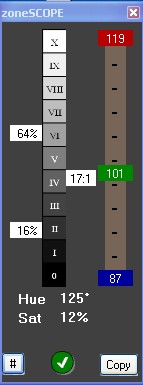 ___
___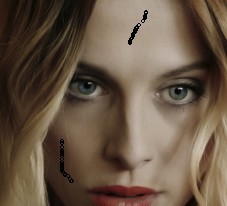 ___
___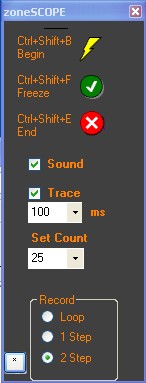 ___
___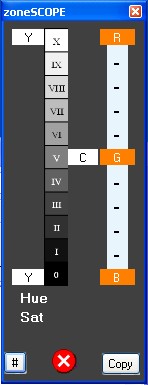
During grading you are directly ("online") able to see what you change. This includes Y_high, Y_low, contrast ratio C based on Adam Ansels zones. Hue and Sat is based on YUV to be comparable with most vectorscope results (Maybe I should include Hue/Sat based on YCbCr Rec 709). RGB meter is based on Mean value of all selected points and very useful for skin adjusment (purple/yellow). On other than skin colors it will certainly change the order.
To compare different shots a screenshot copy of the zoneSCOPE can be automatically attatched to the right or bottom.

 zoneSCOPE.jpg152 x 381 - 14K
zoneSCOPE.jpg152 x 381 - 14K
 zoneSCOPE_settings.jpg146 x 383 - 15K
zoneSCOPE_settings.jpg146 x 383 - 15K
 zoneSCOPE_StartScreen.jpg148 x 385 - 13K
zoneSCOPE_StartScreen.jpg148 x 385 - 13K
 zoneSCOPE_PickedZone.jpg227 x 206 - 11K
zoneSCOPE_PickedZone.jpg227 x 206 - 11K
 zoneSCOPE_ValuesFromImage.jpg143 x 385 - 13K
zoneSCOPE_ValuesFromImage.jpg143 x 385 - 13K -
@shian sorry that I tried to express too much by few sentence. Maybe its best idea to show on demo video how it works stepwise. In general my aim is to have an additional tool to follow (your) lightning tutorials and also be able to quickly analyse small regions like as usually done by region selection with power windows in combination with looking at vectorscope/waveform monitors.
I have also some basic issues like you would realize on above picture where I would measure a contrast ratio of 17:1. I'm not experienced but I assume you would say that this value is much too high.
-
Meanwhile appearance of zoneSCOPE program has changed a little bit. Just a demo how it looks when focusing on Luminance. It also works with Chrominance.
zoneSCOPE can analyze certain parts of an image or video. It's an independent (Windows System) running program and can be used together with different Software Systems like Internet Explorer, Media Player, Photoshop Pro/Elements, Gimp, Adobe Premiere Pro/Elements, Adobe After Effects, Sony Vegas Pro/Movie Studio, Magix Pro/Video Deluxe, DaVinci Resolve etc.
-
@vicharris Thanks for the positive feetback. I thought that people would laugh and say I have my RGB parade, my waveform monitor, my vectorscope, my calibrated screen and my power windows where I also can focus on things like that. I see its especially usefull if one starts to learn color grading. It's useful to analyze a look of a movie and learn about the behavior of different grading tools.
Just come back to the point of contrast ratio. When it comes to a change in contrast ratio during grading its easy to see that you always have to draw back saturation. How much you have to draw back you can immediately analyze precisely with this tool. With Davinci Resolve its amazing to see how good Luminance and Chrominance can be separately handled due its YRGB color space treatment.
@shian you are right. This demo is really technical and my aim was just to show that it works. I might think about commericalizing this program but this will be hard work to do it proper. And many thanks, a good teaser with legal images would help. The cheat sheet which you use for your tutorials is very helpful. %-values do perfectly fit to Luminance Rec. 709 calculations. The S-curve (RGB vs Zone) can also practically be achieved when you expose 18% gray-card differently with a camera like the GH2. Just analyze resulting RGB values and divide them into 11 zones. That was a proof for me to take this sheet as a base for luminance calculations and not other published data mainly based on Lab color space results.
-
Now I started to build up a website for zoneSCOPE. You can already download and try it. As soon as I have more time I will put it on a seperate thread. Hope you have some ideas for improvements.
Enjoy!
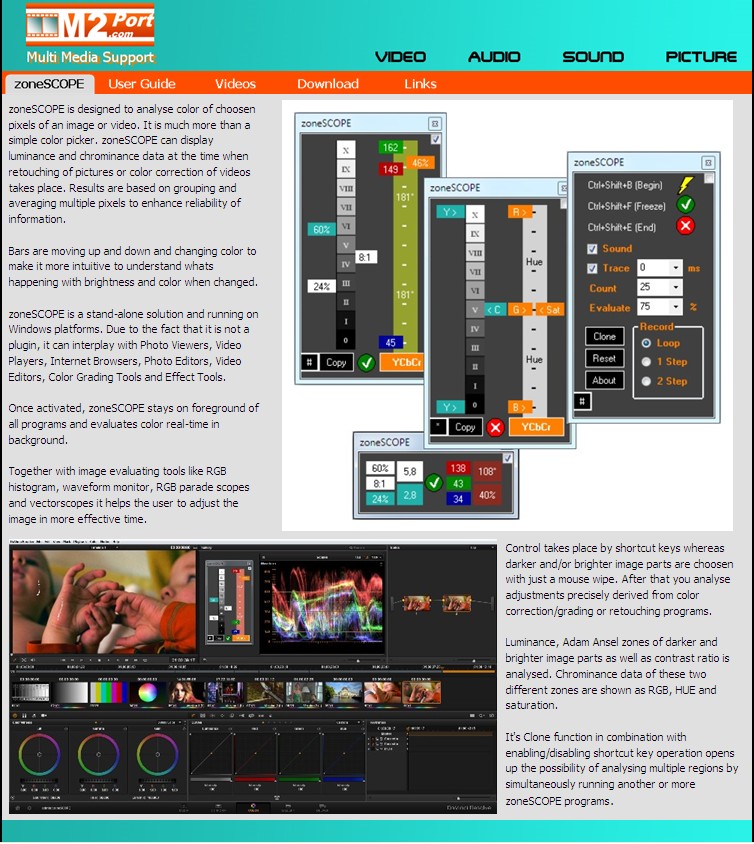

 M2Port Website.jpg754 x 844 - 188K
M2Port Website.jpg754 x 844 - 188K -
Depending on the simplicity of use and how it works in the field, this could be an amazing on set tool. You should bring it up on Roger Deakins' forum and see if there's any interest from him (especially since he's going all digital and the light meter that he uses utilizes a simplified version of the zone system) or any of the other cinematographers that frequent the site.
Keep us updated!
-
@Rszanto thanks for this idea. Do you have a special thread of Roger Deakins forum in mind.
I hope I undestand it right as my knowledge is far away from film industry. You think about laptop with frame grabber to bring HDMI signal online on laptop screen. Then use just a camera with HDMI output as lightmeter to place light sources for the scene.
That would definitely work out as it interplays live even with USB webcams. You would have total freedom to monitor light as you can clone zoneSCOPE, place pixel grabs where you want to analyse contrast ratio and even move with mouse to check zones quickly with another clone.
-
Just register (they're pretty careful against spam, so it might take a day or two to get verified) and post it in the "Tools" sub-forum asking if it's something that might be useful for cinematographers on set:
http://www.rogerdeakins.com/forum2/viewforum.php?f=6&sid=901d86fa9b85a0c92572037919278e12
I'm not even sure I'm seeing this program as its intended to be used, but as an on set reference, it seems to have a lot of potential.
-
Now that I'm on board with the ColorGHear system and watched and understood this video, can you tell me how this would work with the GH3? Should I be primarily using the Histogram or the Exposure Meter?
-
Works exactly the same. The GH3 doesn't have that much more DR over the GH2 - add maybe 2/3 of a stop MAX to your upper and lower limits - Myself I'd only add a 1/3 of a stop.
I always use the spot meter, and a handheld meter. Mostly the handheld meter.
Howdy, Stranger!
It looks like you're new here. If you want to get involved, click one of these buttons!
Categories
- Topics List23,990
- Blog5,725
- General and News1,353
- Hacks and Patches1,153
- ↳ Top Settings33
- ↳ Beginners256
- ↳ Archives402
- ↳ Hacks News and Development56
- Cameras2,367
- ↳ Panasonic995
- ↳ Canon118
- ↳ Sony156
- ↳ Nikon96
- ↳ Pentax and Samsung70
- ↳ Olympus and Fujifilm101
- ↳ Compacts and Camcorders300
- ↳ Smartphones for video97
- ↳ Pro Video Cameras191
- ↳ BlackMagic and other raw cameras116
- Skill1,960
- ↳ Business and distribution66
- ↳ Preparation, scripts and legal38
- ↳ Art149
- ↳ Import, Convert, Exporting291
- ↳ Editors191
- ↳ Effects and stunts115
- ↳ Color grading197
- ↳ Sound and Music280
- ↳ Lighting96
- ↳ Software and storage tips266
- Gear5,420
- ↳ Filters, Adapters, Matte boxes344
- ↳ Lenses1,582
- ↳ Follow focus and gears93
- ↳ Sound499
- ↳ Lighting gear314
- ↳ Camera movement230
- ↳ Gimbals and copters302
- ↳ Rigs and related stuff273
- ↳ Power solutions83
- ↳ Monitors and viewfinders340
- ↳ Tripods and fluid heads139
- ↳ Storage286
- ↳ Computers and studio gear560
- ↳ VR and 3D248
- Showcase1,859
- Marketplace2,834
- Offtopic1,319






